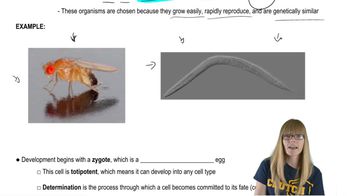Mitochondrial replacement therapy (MRT) offers a potential solution for women with mtDNA-based diseases to have healthy children. Based on what you know about the importance of nuclear gene products to mitochondrial functions, will MRT ensure that children will not inherit or develop a mtDNA-based diseases?
Table of contents
- 1. Introduction to Genetics51m
- 2. Mendel's Laws of Inheritance3h 37m
- 3. Extensions to Mendelian Inheritance2h 41m
- 4. Genetic Mapping and Linkage2h 28m
- 5. Genetics of Bacteria and Viruses1h 21m
- 6. Chromosomal Variation1h 48m
- 7. DNA and Chromosome Structure56m
- 8. DNA Replication1h 10m
- 9. Mitosis and Meiosis1h 34m
- 10. Transcription1h 0m
- 11. Translation58m
- 12. Gene Regulation in Prokaryotes1h 19m
- 13. Gene Regulation in Eukaryotes44m
- 14. Genetic Control of Development44m
- 15. Genomes and Genomics1h 50m
- 16. Transposable Elements47m
- 17. Mutation, Repair, and Recombination1h 6m
- 18. Molecular Genetic Tools19m
- 19. Cancer Genetics29m
- 20. Quantitative Genetics1h 26m
- 21. Population Genetics50m
- 22. Evolutionary Genetics29m
15. Genomes and Genomics
Genomics and Human Medicine
Problem 21a
Textbook Question
Applied to the study of the human genome, a goal of GWAS is to locate chromosome regions that are likely to contain genes influencing the risk of disease. Specific genes can be identified in these regions, and particular mutant alleles that increase disease risk can be sequenced. To date, the identification of alleles that increase disease risk has occasionally led to a new therapeutic strategy, but more often the identification of disease alleles is the only outcome.
From a physician's point of view, what is the value of being able to identify alleles that increase the risk of a particular disease?
 Verified step by step guidance
Verified step by step guidance1
Understand the purpose of GWAS (Genome-Wide Association Studies): GWAS is used to identify genetic variations associated with specific diseases by analyzing the genomes of many individuals. This helps locate regions on chromosomes that may contain genes influencing disease risk.
Recognize the importance of identifying alleles: Identifying alleles that increase disease risk allows researchers and physicians to understand the genetic basis of diseases, which can lead to better diagnostic tools and targeted treatments.
Consider the physician's perspective: From a physician's point of view, knowing which alleles increase disease risk can help in early diagnosis, personalized medicine, and preventive care strategies for patients who carry these alleles.
Explore therapeutic implications: While identifying disease alleles does not always lead to immediate treatments, it can provide insights into the biological pathways involved in the disease, potentially guiding future drug development or therapeutic interventions.
Emphasize patient care benefits: Physicians can use this genetic information to counsel patients about their risks, recommend lifestyle changes, or suggest regular screenings to monitor for early signs of the disease.
 Verified video answer for a similar problem:
Verified video answer for a similar problem:This video solution was recommended by our tutors as helpful for the problem above
Video duration:
2mPlay a video:
Was this helpful?
Key Concepts
Here are the essential concepts you must grasp in order to answer the question correctly.
Genome-Wide Association Studies (GWAS)
GWAS are research methods used to identify genetic variants associated with specific diseases by scanning the genomes of many individuals. This approach helps pinpoint regions of the genome that may harbor genes influencing disease risk, allowing researchers to correlate genetic variations with health outcomes. The findings from GWAS can lead to a better understanding of the genetic basis of diseases and inform future therapeutic strategies.
Recommended video:
Guided course

Genetics of Development
Alleles and Disease Risk
Alleles are different versions of a gene that can exist at a specific locus on a chromosome. Some alleles may be associated with an increased risk of developing certain diseases, often due to mutations that affect gene function. Identifying these risk alleles is crucial for understanding the genetic predisposition to diseases, which can guide preventive measures and personalized treatment options for patients.
Recommended video:
Guided course

New Alleles and Migration
Clinical Implications of Genetic Testing
The ability to identify alleles that increase disease risk has significant clinical implications, including risk assessment, early intervention, and personalized medicine. Physicians can use this information to inform patients about their genetic risks, recommend lifestyle changes, or initiate monitoring for early signs of disease. Additionally, understanding genetic risk can help in developing targeted therapies and improving patient outcomes.
Recommended video:
Guided course

Modern Genetics

 6:51m
6:51mWatch next
Master Human Genome Composition with a bite sized video explanation from Kylia
Start learningRelated Videos
Related Practice
Textbook Question
451
views
